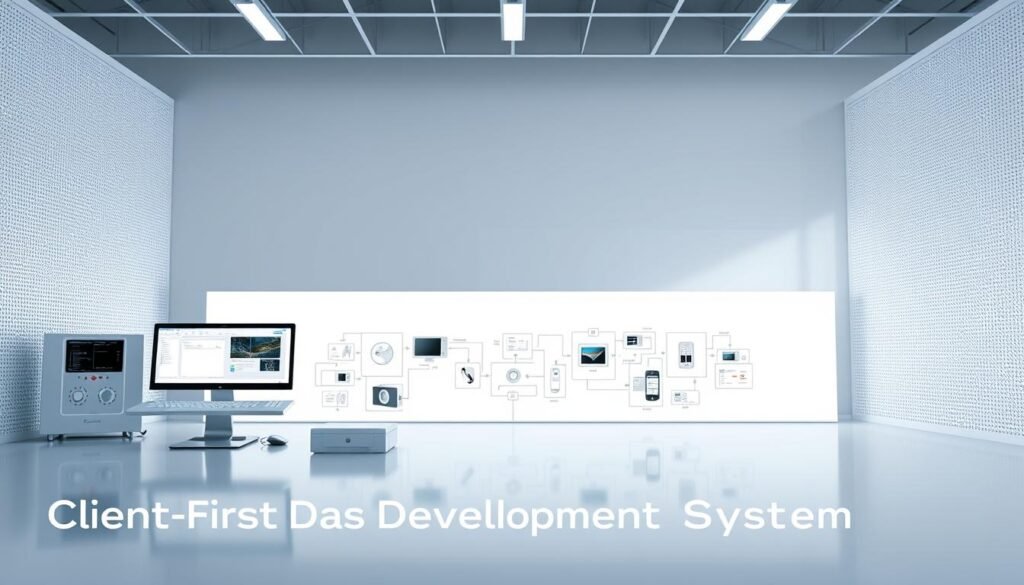What if you could build a professional, responsive website without writing a single line of code? Modern businesses need sleek, fast-loading websites that adapt to any device. With the right tools, anyone can create stunning designs—no technical expertise required.
Webflow bridges the gap between visual design and development. It offers enterprise-grade security, AI-powered tools, and seamless CMS integrations. Whether you’re a solo designer or part of a large team, this platform scales with your needs.
Fortune 500 companies trust it for mission-critical sites, proving its reliability. Unlike traditional CMS platforms, it combines flexibility with power. From no-code simplicity to advanced customization, it’s built for every skill level.
Key Takeaways
- Build responsive websites without coding knowledge.
- Use AI-powered tools for faster design workflows.
- Enterprise-grade security keeps your site protected.
- Seamlessly integrate with CMS and third-party apps.
- Scalable for solo creators and large teams alike.
Introduction to Webflow
Powering over 2M sites, this tool redefines how we create for the web. What began as a prototyping solution now delivers full-stack capabilities—blending design and code into one seamless workflow.
Its visual development framework lets you build production-ready apps without deep coding knowledge. Tools like Wized extend functionality with custom JavaScript, perfect for dynamic interfaces.
Ranked top in G2’s 2024 website builder rankings, the platform caters to all skill levels. Designers craft UIs in the Designer, while content teams update live sites via the Editor.
Unlike traditional coding or rigid no-code alternatives, it balances flexibility with control. Integrate Airtable, automate workflows, and scale from marketing sites to complex web apps—all from one hub.
Why Choose Webflow for Responsive Design?
Responsive design is no longer optional—it’s essential for modern websites. Users expect seamless experiences across phones, tablets, and desktops. Traditional methods often require manual coding, but visual tools simplify the process.
Intuitive Drag-and-Drop Interface
Build layouts visually with a library of 3,500+ pre-built elements. Adjust breakpoints without writing media queries. Real-time previews show how designs adapt across six screen sizes.
Flexbox and CSS Grid are implemented through simple controls. Toggle component states for interactive menus or hover effects. Overflow settings ensure mobile layouts stay clean.
No-Code to Low-Code Flexibility
Start with drag-and-drop, then extend with custom code as needed. Flowbase integrates GSAP animations for advanced interactions. Conditional visibility hides or shows content based on device type.
The Client-First system keeps projects organized. Mobile-first indexing is baked in, boosting SEO. Compared to traditional coding, projects launch 50% faster (Wized case study).
Key Features of Webflow
Modern businesses demand powerful tools that simplify website creation while maintaining professional standards. The platform combines AI-driven design, reliable hosting, and seamless teamwork to deliver exceptional results.
AI-Powered Design Tools
AI layout generators accelerate prototyping with smart suggestions. The content rewrite assistant optimizes text for SEO, while automatic image compression ensures fast load times.
Designers save hours with intuitive tools that adapt to their workflow. No manual coding is needed for responsive adjustments.
Scalable Hosting Solutions
Enjoy 99.99% uptime with a global CDN. Bandwidth scales from 25GB to unlimited, perfect for growing traffic.
Enterprise-grade security includes DDoS protection and automated SSL. Compliance with GDPR and CCPA is built in.
Advanced Collaboration Tools
Teams work efficiently with real-time co-editing and version history. Role-based permissions support 10+ user types for controlled access.
Staging environments let you test changes before publishing. Custom domains and audit logs simplify management.
Webflow’s Visual Development Framework
Advanced web projects demand tools that blend simplicity with powerful customization. The platform’s framework supports everything from marketing sites to interactive applications—no manual coding required.
Building with Wized for Advanced Applications
Wized extends functionality for complex projects like LMS systems or multi-step forms. Create dynamic dashboards with real-time data or shopping carts beyond standard eCommerce plans.
Implement user authentication flows without plugins. Persistent sessions store preferences securely. Custom API connectors integrate external services seamlessly.
Custom Attributes for Enhanced Functionality
Use fs-filter attributes for advanced CMS filtering. Scroll-triggered animations add parallax effects. Conditional rendering enables A/B testing without extra tools.
Add complex form validation and error handling. The framework adapts to your project’s needs, whether simple or enterprise-grade.
Webflow CMS and Content Management
Efficient content management is the backbone of every successful website. Modern CMS platforms streamline workflows, allowing teams to publish, edit, and organize content effortlessly. With built-in tools for scalability, even complex projects stay manageable.

Seamless Airtable Integration
Sync data bidirectionally between Airtable and your CMS in real time. Automate updates, maintain draft states, and schedule posts without manual effort. This integration is ideal for teams juggling multiple platforms.
Dynamic Content with Collections
Create structured content using nested collections and reference fields. Build knowledge bases, multilingual sites, or faceted search systems. Dynamic sitemaps and SEO meta tags update automatically as content changes.
Webflow for Teams
Collaboration is key when building high-quality websites efficiently. The right tools streamline teamwork, ensuring projects stay on track and brand guidelines are followed.
Roles and Permissions
Granular access controls let you define 10+ user roles. Clients get view-only access, while developers edit code. Freelancers receive time-limited permissions.
Single sign-on (SSO) simplifies logins for enterprise teams. Audit logs track changes, and element locking prevents conflicts during active development.
Design Approval Workflows
Set up multi-stage review chains with annotations. Version comparisons highlight edits, and style guides enforce consistency.
Automated project briefs save time, while conditional publishing ensures only approved updates go live. Every step is optimized for smooth teamwork.
Webflow Hosting and Security
Your site’s performance and security directly impact user trust and search rankings. A slow or vulnerable website drives visitors away and hurts conversions. The right hosting solution combines speed, reliability, and advanced protection.
Reliable, Fast Hosting
A global CDN with 200+ edge locations ensures lightning-fast load times worldwide. HTTP/3 support reduces latency, while automatic image optimization via Kraken.io keeps pages lean.
Daily backups with 90-day retention safeguard your data. Staging environments let you test changes securely before they go live.
Enterprise-Grade Security Features
DDoS protection with 2Tbps capacity shields against attacks. SOC 2 Type II certified infrastructure guarantees compliance for sensitive data.
Custom SSL certificates and IP allowlisting restrict admin access. Vulnerability scans and HIPAA-ready options meet strict industry standards.
Key advantages:
- Automated backups and one-click restore
- Password-protected staging for client reviews
- Real-time threat detection and patching
APIs and Integrations
Modern websites rely on seamless connections to third-party tools for enhanced functionality. With 150+ native integrations, you can automate workflows and sync data effortlessly.
Native Integrations
Connect payment processors like Stripe or PayPal for secure transactions. Sync CRM platforms such as HubSpot or Salesforce to manage leads. Live chat via Intercom improves customer support.
Google Tag Manager simplifies analytics tracking. Pre-built webhooks automate unique processes, saving hours of manual work.
Custom API Connections
Extend functionality with custom code using Wized for internal APIs. Migrate content programmatically or implement OAuth for third-party logins.
Build middleware between Airtable and your CMS. Monitor all connections in real-time through the dashboard for full control.
- Automate marketing with Zapier/Make
- Embed dynamic content from APIs
- Scale securely with enterprise-grade endpoints
Webflow Components Library
Speed up development with ready-to-use components that adapt to any screen size. The platform’s library includes 3,500+ elements, from buttons to GSAP animations, reducing repetitive coding tasks.
Pre-Built UI Components
Drag and drop responsive navigation menus, cookie consent banners, or pricing tables. Interactive data tables with sorting save hours of manual work. Testimonial sliders pull content directly from your CMS.
Accordions, tabs, and mega menus with image support simplify complex layouts. Multi-step forms include progress tracking for better user experience.
Custom JavaScript Solutions
Extend functionality with advanced filtering systems or parallax scroll effects. GSAP animations add polish without code. Conditional logic tailors components to user actions.
Key advantages:
- Reusable elements for consistent branding
- Mobile-first designs built-in
- CMS bindings for dynamic content
Client-First Development System
Structured workflows transform chaotic development into efficient processes. The Client-First system, adopted by 35,000+ developers, standardizes project architecture for scalability. It ensures consistency from solo freelancers to enterprise teams.

Organized Project Structures
Implement class naming conventions like .card__title for clarity. Virtual folders group assets logically, while reusable style combinations save hours. Global color variables and spacing systems adapt to any screen size.
Document components with inline notes for seamless handoffs. Isolated CSS reduces conflicts, and version control tracks every change. This project framework aligns with WCAG 2.1 accessibility standards.
Maintainable Code Practices
Write clean code with modular components for easy updates. Conditional classes enable dynamic layouts without redundancy. Automated audits flag unused styles, keeping files lean.
Teams collaborate faster with shared libraries and role-based permissions. The system’s flexibility supports growth—from marketing sites to complex web apps. Every decision prioritizes long-term efficiency.
SEO Optimization with Webflow
Strong SEO is the backbone of online visibility, turning visitors into customers. The right tools automate complex tasks while ensuring your site meets search engine standards. From schema markup to multilingual support, every detail impacts rankings.
Technical SEO Best Practices
Automatically generate XML sitemaps and canonical tags to avoid duplicate content issues. Implement hreflang tags for multilingual sites, ensuring correct language targeting.
Optimize Core Web Vitals by compressing images and leveraging browser caching. Redirect chains are handled automatically, preserving link equity during site updates.
On-Page SEO Strategies
Create SEO-friendly URLs and optimize image alt text at scale. Use the CMS to build topic clusters, reinforcing authority on key subjects.
Schema markup is added through a visual UI, enhancing rich snippets. Monitor rankings via native integrations with Google Search Console.
Key advantages:
- Dynamic sitemaps update with new content
- Automated redirects for migrated pages
- Real-time content gap analysis
Webflow Extensions and Tools
Boost productivity with specialized extensions that enhance design workflows. These add-ons solve unique challenges, from CMS management to responsive scaling. Developers and designers save hours by automating repetitive tasks.
Finsweet Extension for Workflow Efficiency
The Finsweet extension simplifies complex processes with one-click improvements. Sort CSS classes alphabetically or clean unused styles automatically. Bulk-edit CMS fields and manage color swatches globally for consistency.
Duplicate interactions between elements to maintain uniformity. Resize the canvas vertically for tall sections, ensuring precise designs. Export specs for developers, reducing back-and-forth communication.
Chrome Web Store Add-Ons
Browser extensions from the Chrome Web Store expand functionality further. Integrate Figma designs seamlessly or inject global code snippets. Visual breakpoint reordering ensures mobile-first designs adapt flawlessly.
Scale text responsively across devices without manual adjustments. These tools empower teams to focus on creativity, not technical hurdles.
Case Studies: Success with Webflow
Leading organizations achieve digital excellence with streamlined solutions. These real-world examples showcase measurable improvements in speed, cost, and scalability.
Jack.org’s Custom LMS
Jack.org built a custom learning management system (LMS) to serve 60k+ students. The Wized-powered platform reduced development cycles by 40% and cut maintenance costs by 75%.
Dynamic content updates and role-based access simplified course management. Over 18 months, the project delivered a 300% ROI through increased engagement and reduced overhead.
Enterprise-Grade Implementations
Fortune 500 companies rely on the platform for high-traffic sites handling 500k+ users. Complex workflows, like multi-region compliance setups, run seamlessly.
Migrating from WordPress or Drupal improved performance by 60%. Custom membership systems and global CDNs ensure reliability for mission-critical applications.
Webflow Community and Support
Behind every great tool is an even greater network of experts and learners. The platform’s community offers instant access to shared knowledge, troubleshooting tips, and industry trends. Whether you’re a beginner or a seasoned pro, collaborative spaces accelerate problem-solving.
Finsweet+ Membership Benefits
Upgrade your workflow with Finsweet+, a premium tier for dedicated users. Members enjoy priority support, including faster response times for technical tickets. Early access to beta features lets you stay ahead of updates.
Exclusive perks include a private Slack group for real-time discussions and 10% discounts on tools. Annual conferences and live Q&A sessions connect you with industry leaders. Contributor programs recognize top problem-solvers, while a job board helps professionals find opportunities.
Community-Driven Resources
Tap into a library of tutorials, templates, and component kits curated by users. The resources cover everything from basic layouts to advanced interactions. Forums and Discord channels offer peer-to-peer advice, reducing reliance on official support.
Seasonal challenges and hackathons encourage skill-building. Shared style guides and reusable assets maintain consistency across projects. This ecosystem turns individual creativity into collective progress.
Getting Started with Webflow
Launching a professional site is easier than ever with the right plans and tools. Whether you’re a freelancer or part of a team, the platform scales to fit your goals. Begin with a free tier or jump into advanced features for complex projects.
Free vs. Paid Plans
The free plan includes basic features like responsive templates and 2 CMS items. Paid tiers start at $18/month, unlocking custom domains, team collaboration, and higher traffic limits.
Key comparisons:
- Starter: Best for testing ideas (free forever).
- Pro: Includes client billing and 10K monthly visits.
- Enterprise: Custom SLAs and unlimited projects.
Step-by-Step Setup Guide
Follow these steps to get started efficiently:
- Calculate traffic needs based on audience size.
- Connect a domain or use a Webflow subdomain.
- Configure global styles for brand consistency.
Post-launch, monitor performance with built-in analytics. Optimize SEO meta tags and enable backups for security.
Conclusion
Transform your digital presence with Webflow, a platform that grows with your business. From responsive designs to enterprise-grade security, it delivers end-to-end solutions without coding.
Expect faster results with AI-powered tools and seamless integrations. Whether launching a startup site or scaling globally, the platform adapts to your needs.
Continuous updates ensure long-term value. Try the free tier or consult experts to kickstart your project. Invest in a tool that keeps your business ahead—start building today.
FAQ
What makes Webflow different from other website builders?
Webflow combines a drag-and-drop editor with custom code control, allowing designers and developers to build responsive sites without limitations. Unlike traditional platforms, it offers CMS-powered content and enterprise-grade hosting.
Can I integrate third-party tools with Webflow?
Yes. It supports native integrations like Airtable, Zapier, and Shopify. For advanced needs, custom APIs can connect to external databases or services.
Is Webflow suitable for large teams?
Absolutely. Features like role-based permissions, design workflows, and real-time collaboration streamline teamwork for agencies and enterprises.
How does Webflow handle SEO?
Built-in tools optimize meta tags, structured data, and page speed. The platform also allows custom schema markup for deeper search engine control.
Are there pre-built components to speed up development?
Yes. The components library includes UI elements like navbars, forms, and sliders. For advanced needs, JavaScript solutions can be added.
What hosting options does Webflow provide?
It offers fast, global hosting with automatic SSL, CDN, and 99.9% uptime. Enterprise plans include DDoS protection and custom infrastructure.
Can I export my Webflow site’s code?
Yes. Sites can be exported as clean HTML, CSS, and JavaScript for self-hosting or further development outside the platform.
Does Webflow support animations?
Yes. The visual interactions editor lets you create scroll, hover, and click animations without writing code.
Is there a free plan to test Webflow?
Yes. The free tier includes basic features, while paid plans unlock CMS, e-commerce, and team collaboration.
How does the Client-First system improve projects?
It standardizes naming conventions and file structures, making designs easier to maintain and scale for long-term use.
